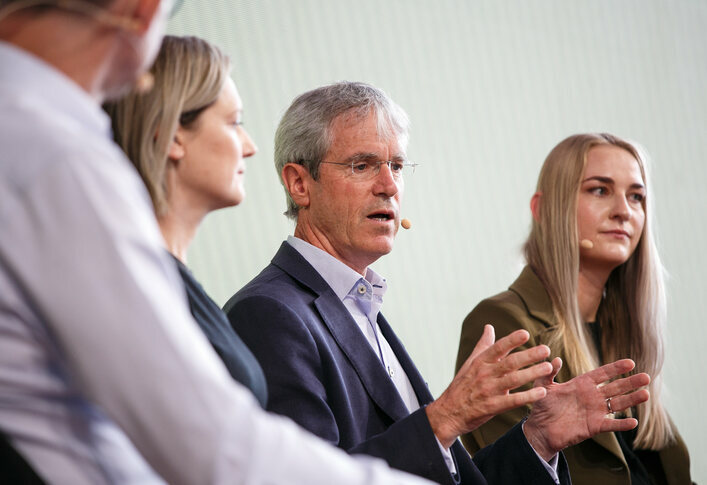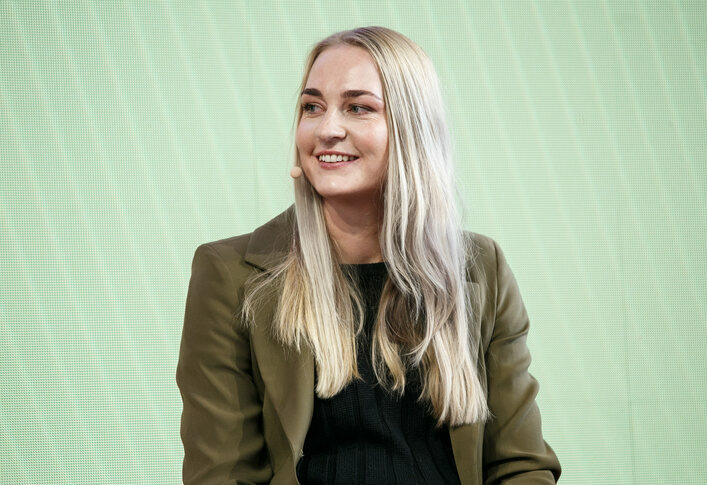



Rabobank panel: Consumers want to know the agricultural supply chain journey
Panel agrees in the power of building traceability and connecting consumers into the journeyThe function of a modern supply chain has moved well beyond a process, rather, it represents an opportunity for storytelling, collaboration and consumer connection.
This was one of the main ‘take-homes’ from the recent Rabobank Farm2Fork Summit panel sessions, From Paddock to Plate: Navigating the most significant Supply Chain Trends, which provided an opportunity for some of Australia and New Zealand’s biggest brands to discuss current trends and insights.
Facilitated by Nick Fereday, Executive Director Food & Consumer Trends, RaboResearch F&A North America, panellists included Sarah Heazlewood from Woolworths Group, Mark Wynne from Ballance Agri-Nutrients, Lucy Macdonald from Middlehurst Station, Mark Ryan from Tassal Group and Andrew Fletcher from Fonterra.
There was strong consensus across the panel on the power of building traceability into supply chains and connecting consumers to the journey, for greater transparency and reputation.

Using social media to its advantage, Mark Ryan said Tassal was looking at ways to further engage consumers, including the possibility of utilising cameras they have in each salmon pen for even more visibility.
“Imagine buying a fish and having the ability to physically watch its lifecycle,” he explained. “We want to take the consumer on a journey and showcase how that fish was raised ethically, with a low carbon footprint – it’s another way to show our consumers that they can trust our food, and that we’re delivering a quality offering, but it takes commitment and courage to put yourself out there.”
Lucy Macdonald, who together with her family runs a merino meat operation, delivers product directly to consumers through branded boxed meat and restaurants.
As a direct consumer business Macdonald said customers were becoming increasingly inquisitive about their whole supply chain and how it operates, and that her family encouraged the public to be engaged and curious.
“We want to show people our business, and we consciously focus on our biodiversity story – which includes our social responsibility, environmental sustainability, animal welfare, traceability and transparency,” she said.
“Consumers are demanding more, and we’re in a fortunate position to be able to facilitate their connection with the farmer and producer – and help build a supply chain that they can look in, see every step of the journey, and build that relationship.”
Despite being at the other end of the supply chain Mark Wynne believes that connecting consumers is still imperative.
“From the consumer, back to the retailer, back to the processer, farmer, and then our nutrient company, there are a lot of people in the middle, so we need to go directly to the consumer to actually understand what it is they’re thinking in regards to their food, and the role of nutrients.”
Wynne outlined how Ballance Agri’s response framework looked at the ‘Four Rs’ – having the right product in the right place, in the right amount, at the right time.
“One example of having the right product is our low water soluble super phosphate, which is still 100 per cent plant available, so if it gets washed into the streams, you’re unlikely to get an algae bloom, but you get the same productivity on-farm,” he said.
Remaining relevant in a supply chain embracing change
Wynne continued to keep the audience entertained, outlining that “Change – it’s not a four letter word, but often your response to it is, and that's depending on whether you’re initiating the change, or it's being done to you!”
“My recommendation would be you lead that change, listen to your consumer, innovate as fast as you can, excite and delight them and that’s how you’ll win,” he said.
Recognising that environmental sustainability can be overwhelming for lots of producers and small businesses, Macdonald said their approach to the subject was “How do you eat an elephant? One bite at a time. We break our sustainability objectives down into small, achievable goals that we can follow through on so it’s not so overwhelming.”
Through her role specialising in value chain emissions for Woolworths, Sarah Heazlewood believed relevance was underpinned by understanding the interaction between emissions and how a business operates – and not seeing them as two separate things.
“It’s really important to recognise that knowledge and research is still building, and we’re all learning together, and I don’t think there’s always a clear path forward,” she said.

As for ‘how’ to remain relevant, Heazlewood explained that Woolworths follows three key principles that helps guide the business on how it understands its own emissions and subsequent business interactions – the first being learning from others.
“Some businesses have already started on their emissions journey, and by learning from others we can start a few further steps down the path,” she explained.
Prioritising was her second key principle.
“There are so many people doing so many different things, it can be hard to focus, so from an emissions point of view it’s about prioritising and spending more time dedicated to fewer things – whether that’s dairy, coffee, chocolate or meat…take the time for a thorough understanding,” she said.
Not waiting for the perfect way forward, was Heazlewood's third rule.
“We look for progress over perfection, and working with people who want to learn together so we can, hopefully, move faster, together,” she said. “Recognising that this can be a noisy space, having a clear objective of what you want to achieve can be so important – is your objective to understand your footprint and where you’re at? Is it to put carbon neutral products into the market? Is it to reduce emissions? Being really clear on objectives can cut down so much of the noise on how to get there.”
Mark Wynne said another way to ensure relevance was to have clear expectations on what a customer is willing to pay for within your sustainability framework.
“Some of the costs the business is going to have to absorb, but, for example, if we can take carbon dioxide out of our ammonia plant by using green hydrogen to make greener urea – people will pay for that quite happily,” said Wynne.
“It’s all about understanding what value do you think you’re adding, verse what value are you adding to the consumer, to drive that positive choice."
Over at Tassal, Mark Ryan said one thing that he had learned over the past three years was that there’s a greater responsibility beyond one's own business.
“It’s about bringing communities and consumers on your journey, for example, we’re now Australia’s largest seaweed farm, growing seaweed to take nitrogen out of our water system and restore the balance after feeding our prawns nitrogen-rich feed,” said Ryan. “Now, we have opportunities in the beef and cattle industry to reduce methane by 97 per cent using that seaweed – it’s a great story and connection, and it’s about being responsible for what you’re doing, plus playing a part in the whole value chain.”
More often than not, sustainability was being narrowly translated into environmental greenhouse gas emissions, Andrew Fletcher, of Fonterra, explained to the 1,600 strong audience, however he believed sustainability was holistic.
“It’s about how you treat your labour, your animals, and sustainability is here to stay, so businesses need to look at all those elements, and where possible, measure it – get a baseline, work out things that can be moved that make sense economically, the easy wins, and get started on those,” he said.
He said building a plan and being prepared to talk with supply chain partners about that plan was key.
“It’s about the progress being made, not just the absolute numbers, it’s about finding others who will help you along the way and want to share in your journey,” said Fletcher.
With many major ingredient customers now visiting Fonterra on-site, Fletcher said all were keen to talk greenhouse gas emissions and sustainability.
“Most of them have made commitments typically towards the 2030 horizon for supply chain reductions, and for many dairy is the biggest contributor to their scope three emissions,” said Fletcher. “They want to engage, and it’s not ‘what can you do for us?’ but rather, it’s ‘how can we help, how can we get involved? How can we help get things implemented?’ – these partnerships are so important to achieving efficient, low emissions supply chains.”
Stronger together: Sustainability driving collaboration
The panel also discussed how sustainability as a common goal was driving relationships.
Certainly for Woolworths, Sarah Heazlewood said sustainability was a way to encourage collaboration and move things forward faster, together.
“We facilitate a number of working groups, which include consumers right through to retailers working all the way through the value chain,” she said. “Participating as a group enhances knowledge, helps work towards a solutions phase faster.”
She said collaboration was also a great way to recognise that different parts of the value chain have different solutions available to them at different times – some can move now, others are waiting on innovation.

Mark Wynne used Ballance Agri’s hydrogen initiative as an example of positive collaboration, whereby a 50/50 joint venture with Hiringa Energy looked to develop a hydrogen refueller network through New Zealand.
“As a fertiliser company we have a lot of trucks on the road, a lot of movements taking nutrients across the country and this travel will be decarbonised by using hydrogen,” said Wynne.
Without a stable offtake, developing such an industry was erratic, yet through collaboration with Ballance Agri’s manufacturing plant, which runs 24/7, the base load for the hydrogen is set, and Hiringa Energy can take off what they need.
With Tassal having long worked under the premise that you need a healthy environment to have healthy fish, to have healthy profits that can then be reinvested back into the community, Mark Ryan said sustainability had to work in a continuum.
“We also have to realise that 70 per cent of the earth is water – we’ve got to learn to harness that, we’re going on 10 billion people and we can’t feed everyone at the moment, so we’re going to need to be able to supplement, substitute and collaborate to find solutions and use water to grow protein,” said Ryan.
With a growing call from consumers on traceability, the panel agreed that there was valuable opportunity in demonstrating the integrity of food and fibre production, helping educate, add value and pre-empting potential scrutiny through a transparent supply chain story.
Headline image shows the supply chain panel session, facilitated by Nick Fereday, Rabobank, included Sarah Heazlewood, Woolworths Group, Mark Wynne, Ballance Agri-Nutrients, Lucy McDonald, Middlehurse Delivered, Mark Ryan, Tassal Group, and Dr Andrew Fletcher, Fonterra.








